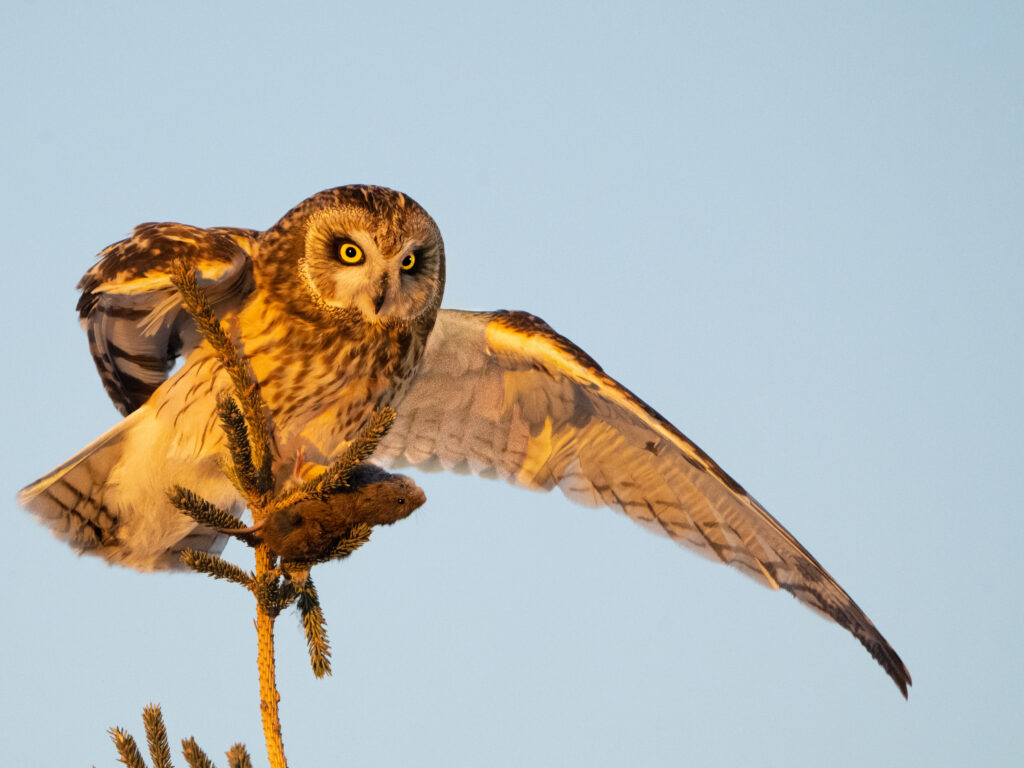Thank you to our Nature Network partner, BeaverHill Bird Observatory, for sharing this month’s blog.
An Irruption of Mystery: The Enigmatic Short-eared Owl
Owls are captivating creatures. They are mysterious and elusive, rarely seen and often poorly understood. In my opinion, the Short-eared Owl (In Inuktitut, Unnuasiutik or Unnuasiutiapik) is one of the best examples of why owls are enchanting to so many people.
Short-eared Owls are a medium-sized owl, named for the small ear tufts that they typically hold flat against their head. The name is somewhat of a misnomer, as these tufts are wholly unrelated to the owl’s actual ears. These tufts are mainly used to communicate mood to other owls, but they also aid in camouflage by breaking up the owl’s silhouette. Their real ears are on the sides of their head, hidden underneath the feathers of their facial disk.

Short-Eared Owl (photo: Hughes de Milleville)
These owls have incredible hearing. Their ears are asymmetric, with one sitting higher than the other on their head. This allows them to triangulate noises: using the delay between when each ear hears a noise, these owls can quickly pinpoint exactly where a noise came from. This allows them to locate prey even if they can’t see it, an important skill for a bird that spends much of its winter catching prey that is hidden beneath the snow!
Short-eared Owls are found in almost every corner of the globe; Antarctica and Australia are the only continents where you can’t find this species. Throughout its range, the Short-eared Owl inhabits open grasslands and fields. They hunt mainly small mammals, but will opportunistically take other prey such as birds, especially if food is scarce. Short-eared Owls are neither diurnal nor nocturnal, and are instead best categorized as crepuscular. Crepuscular, a criminally underused word that your family will accuse you of making up should you try and play it during a heated round of Scrabble, simply means an animal that is most active during dawn and dusk.
When it comes to nesting, Short-eared Owls don’t need anything all that fancy. A cozy spot on the ground, usually with some shrub cover, will suffice. The nests might be lined with some grass or feathers, but they are still rustic even by generous evaluation. These owls typically lay 7 eggs, and roughly half of these offspring will survive until fledging.
One of the reasons I find this species so captivating is their mysterious and nomadic nature. Short-eared Owls are migratory, but the exact nature of their movements is poorly understood. Throughout much of its range in Canada this species is present all year round, but recoveries of banded birds and other studies suggest that most individual birds migrate. One thing that is clear about the movements of these owls is that they are irruptive, invading areas in large numbers during certain years in response to outbreaks of prey species. I typically only see 1-2 Short-eared Owls in a year, but during irruption years I have seen dozens in a single day.
I work at the Beaverhill Bird Observatory near Tofield, Alberta, and the irruption of Short-eared Owls is something we noticed occurring this year! The Beaverhill Bird Observatory has been monitoring bird populations since 1984, operating out of a small research station on the shore of Beaverhill Lake. Much of our research is focused on bird banding. We catch thousands of birds (mostly tiny songbirds like flycatchers, warblers, and sparrows) each year and tag them with a lightweight metal leg band. This band has a unique 9-digit number that isn’t repeated on any other bird in North America, and it allows us to identify that bird as an individual. If these birds are recaptured, we can see where their migrations take them, while also collecting data about population demographics and body conditions of our feathered friends.
Despite all the mystery around Short-eared Owls, one thing has become clear about their populations in recent years: they are declining. Declines have been noted all throughout the widespread range of this species, and this resulted in the Short-eared Owl being classified as ‘Threatened’ by the Committee on the Status of Endangered Wildlife in Canada(COSEWIC) in 2021. These declines are driven by the loss of grassland habitat, as roughly 75% of Canada’s original grasslands have been lost due to agricultural conversion and development.
If you want to help birds like the Short-eared Owl, it’s easy to be a force for good and make the world a better place for them! Advocate for the protection of native prairie, and support organizations like Nature Canada and local land trusts that protect these habitats that Short-eared Owls rely on. You can also make your home safer for all birds by marking the outside of windows to prevent window strikes, and keeping cats indoors to minimize their impact on local wildlife. And of course, you can support organizations like the Beaverhill Bird Observatory that collect valuable long-term data to support the conservation of all our feathered friends!
Want to help Canadian species like the Short-Eared Owl and more? Be a voice for Nature and send a personal letter to the Prime Minister, Environment Minister, and the Oceans Minister demanding wildlife protection.
Sign the Letter!
The post An Irruption of Mystery: The Enigmatic Short-eared Owl appeared first on Nature Canada.



